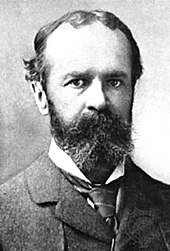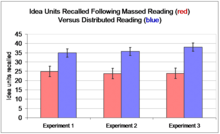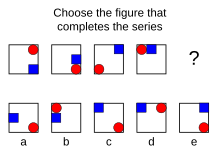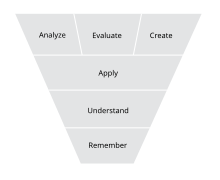Educational psychology
[3] School psychology began with the concept of intelligence testing leading to provisions for special education students, who could not follow the regular classroom curriculum in the early part of the 20th century.[3] Another main focus of school psychology was to help close the gap for children of colour, as the fight against racial inequality and segregation was still very prominent, during the early to mid-1900s.He believed that the mind was like a blank tablet (tabula rasa), and that successions of simple impressions give rise to complex ideas through association and reflection.Locke is credited with establishing "empiricism" as a criterion for testing the validity of knowledge, thus providing a conceptual framework for later development of experimental methodology in the natural and social sciences.Despite stating that the book should not be used as a practical guide to nurturing children, the pedagogical approach outlined in it was lauded by Enlightenment contemporaries including Immanuel Kant and Johann Wolfgang von Goethe.His studies focused on humanistic learning, which opposed scholasticism and was influenced by a variety of sources including philosophy, psychology, politics, religion, and history.The 5 steps that teachers should use are: There were three major figures in educational psychology in this period: William James, G. Stanley Hall, and John Dewey.In his famous series of lectures Talks to Teachers on Psychology, published in 1899, James defines education as "the organization of acquired habits of conduct and tendencies to behavior".[10] He also believed that it was important for teachers to take into account individual students' strengths and also the needs of the classroom as a whole when teaching and creating a good learning environment.[18] "The material furnished by way of information should be relevant to a question that is vital in the students own experience"[18]Jean Piaget (1896–1980) was one of the most powerful researchers in of developmental psychology during the 20th century.[10] In 1954 the work of Kenneth Clark and his wife on the effects of segregation on black and white children was influential in the Supreme Court case Brown v. Board of Education.[10] He advocated for discovery learning where teachers create a problem solving environment that allows the student to question, explore and experiment.[21][22] Despite the demonstrated efficacy of awards in changing behavior, their use in education has been criticized by proponents of self-determination theory, who claim that praise and other rewards undermine intrinsic motivation.Among the memory structures theorized by cognitive psychologists are separate but linked visual and verbal systems described by Allan Paivio's dual coding theory.[31] The critical step of finding a mapping between the problem and a pre-existing schema is often cited as supporting the centrality of analogical thinking to problem-solving.These manifest as individual differences in intelligence, creativity, cognitive style, motivation, and the capacity to process information, communicate, and relate to others.In practice, standardized instruments such as the Stanford-Binet IQ test and the WISC[35] are widely used in economically developed countries to identify children in need of individualized educational treatment.In addition to basic abilities, the individual's personality traits are also important, with people higher in conscientiousness and hope attaining superior academic achievements, even after controlling for intelligence and past performance.Education aims to help students acquire knowledge and develop skills that are compatible with their understanding and problem-solving capabilities at different ages.[37] In the same direction, the neo-Piagetian theories of cognitive development suggest that in addition to the concerns above, sequencing of concepts and skills in teaching must take account of the processing and working memory capacities that characterize successive age levels.Education also capitalizes on cognitive change, because the construction of knowledge presupposes effective teaching methods that would move the student from a lower to a higher level of understanding.[43] A dominant influence on the social constructivist paradigm is Lev Vygotsky's work on sociocultural learning, describing how interactions with adults, more capable peers, and cognitive tools are internalized to form mental constructs.[45] Elaborating on Vygotsky's theory, Jerome Bruner and other educational psychologists developed the important concept of instructional scaffolding, in which the social or information environment offers supports for learning that are gradually withdrawn as they become internalized.[48] Often represented as stages through which people pass as they mature, developmental theories describe changes in mental abilities (cognition), social roles, moral reasoning, and beliefs about the nature of knowledge.For example, educational psychologists have conducted research on the instructional applicability of Jean Piaget's theory of development, according to which children mature through four stages of cognitive capability.A form of attribution theory developed by Bernard Weiner[53] describes how students' beliefs about the causes of academic success or failure affect their emotions and motivations.SDT focuses on the importance of intrinsic and extrinsic motivation in driving human behavior and posits inherent growth and development tendencies.Research has found that mastery goals are associated with many positive outcomes such as persistence in the face of failure, preference for challenging tasks, creativity, and intrinsic motivation.Much of her educational research and publications focused upon the theories of Julian B. Rotter in regard to the importance of internal control and successful academic performance.Within the UK, students must hold a degree that is accredited by the British Psychological Society (either undergraduate or at the master's level) before applying for a three-year doctoral course that involves further education, placement, and a research thesis.





PsychologyOutlineHistorySubfieldsBasic psychologyAbnormalAffective neuroscienceAffective scienceBehavioral geneticsBehavioral neuroscienceBehaviorismCognitiveCognitivismCognitive neuroscienceSocialComparativeCross-culturalCulturalDevelopmentalDifferentialEcologicalEvolutionaryExperimentalGestaltIntelligenceMathematicalNeuropsychologyPerceptionPersonalityPsycholinguisticsPsychophysiologyQuantitativeTheoreticalApplied psychologyAnomalisticApplied behavior analysisAssessmentClinicalCoachingCommunityConsumerCounselingCriticalErgonomicsFeministForensicHealthHumanisticIndustrial and organizationalMedicalMilitaryOccupational healthPastoralPoliticalPositivePsychometricsPsychotherapyReligionSchoolSport and exerciseSuicidologySystemsTrafficBehaviorBehavioral engineeringCognitionCompetenceConsciousnessConsumer behaviorEmotionsFeelingsHuman factors and ergonomicsPsychology of religionTerror management theoryCounseling topicsDisciplinesOrganizationsPsychologistsPsychotherapiesResearch methodsSchools of thoughtTimelineTopicsEducational researchCurriculum studiesEducation sciencesEvaluationPhilosophyTechnologyInternational educationSchool counselingSpecial educationGifted educationFemale educationReligious educationTeacher educationTeaching methodBusinessComputer scienceEarly childhoodEngineeringLanguageLiteracyMathematicsPerforming artsScienceSocial scienceVocationalCase methodConversation analysisDiscourse analysisEvidence-basedFactor analysisFactorial experimentFocus groupMeta-analysisMultivariate statisticsParticipant observationReformlearningbehavioralaffectmotivationclassroom managementmedicinebiology